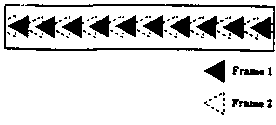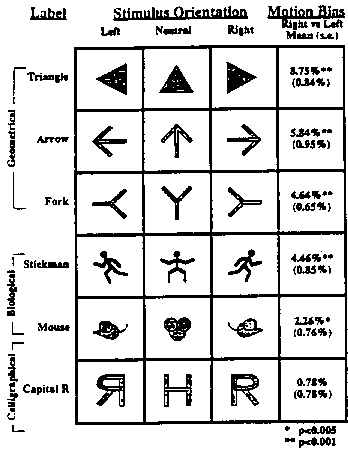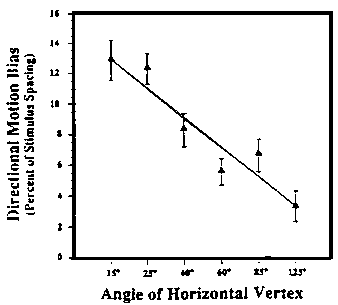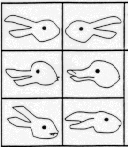Psychological Science, Vol. 3, No. 6, November 1992
Perceptual Bias For Forward-Facing Motion
Michael K. McBeath, Kazunori Morikawa, and Mary K. Kaiser
Abstract
When an occluded horizontal row of shapes is shifted laterally, apparent
motion can be experienced in either the leftward or rightward direction.
Four experiments provide evidence when directionality was specified geometrically
(e.g. triangles), next largest when specified biologically (e.g. mice),
and absent when specified calligraphically (e.g. letter "R").
The bias increased parametrically as a function of triangle pointedness,
and was consistent with the directional interpretation of an ambiguous
duck-rabbit. The results confirm that cognitively-specified forward-facing
orientation can influence experienced direction of motion.

Figure 1. Experimental Technique ^^^
Subjects were presented two-frame
apparent motion using a laterally
shifted row of shapes with a clearly
specified forward-facing direction.
Figure 2. Stimuli and Results, Experiment 2.>>>
Six shapes in left-facing, neutral
and right-facing orientations,
and mean spatial offset required
to cancel out the forward-facing bias
(in percent stimulus spacing).
|
 |
 |
Ambiguous Figure(Both Orientations) |
 |
<Both Orientations
Grouped: 2.37%*
(0.75%)
<All 12 Priming
Figures Grouped:
<4.14%** (0.35%)
|
Figure 4. Results of Experiment 3.
Magnitude of forward-facing bias as a
function of the horizontal angle (or pointedness)
of laterally-aligned isosceles triangles.
|
Figure 5. Stimuli and Results, Experiment 4.
Both orientations of the ambiguous
duck-rabbit plus two samples each from the
unambiguous duck and rabbit priming sets.
The ambiguous stimuli produced a bias
consistent with the forward-facing
direction of each priming set.
|
Go to Top of Page
Go
to McBeath
Research Page
Go to McBeath
Home Page



